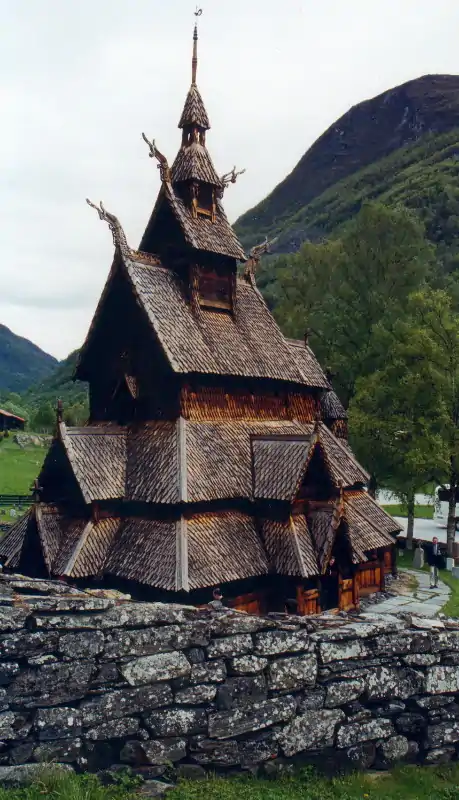Uvdal Stave Church
Uvdal Stave Church (Uvdal stavkirke) is situated at Uvdal in the valley Numedal in Nore og Uvdal in Buskerud, Norway. The stave church was originally constructed just after the year 1168,[1] which is known through dendrochronological dating of the ore-pine used in the construction. The logs were not completely dry when the construction took place.
| Uvdal Stave Church | |
|---|---|
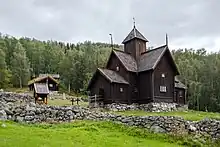 | |
 Uvdal Stave Church Location of the church | |
| 60°15′54″N 8°50′05″E | |
| Location | Buskerud, Nore og Uvdal |
| Country | Norway |
| Denomination | Church of Norway |
| Architecture | |
| Architectural type | Stave church |
| Completed | 1168 |
| Specifications | |
| Materials | Wood |
| Type | Church |
| Status | Automatically listed |
| ID | 85738 |
Construction history
An archeological excavation that took place during 1978[2] showed that the church was built on the remains of a previous church. It is thought to have been made with the use of embedded corner column technology at the beginning of the 11th century.[3]
Churches made during the 12th century were usually very small, often no more than 40 square meters, and were therefore often expanded, even during the Middle Ages and certainly just before and after the Reformation, which took place during 1537 in Norway.
The nave of the church was first expanded to the west during the Middle Ages, when the original apse of the chancel was also removed and the chancel itself elongated. Again, during that period, an extra center column was added. The chancel was torn down again in 1684, when a new and wider chancel was made, with the same width as the nave. Then, during the period 1721–1723, the church was made into a cruciform. A new ridge turret had to be made, to fit the new shape. Later, in 1819, a new vestry was added to the north wall of the chancel.[4]
Exterior
The exterior walls were paneled in 1760.
Interior
Benches with ornately decorated sidewalls were added to the nave in 1624. The oldest part of the interior was probably richly ornately decorated by painting during 1656, the expansions during 1684 and 1723. Two scary halfmasks are quite visible on the poles of the chancel, and according to myth they were able to capture demons.
Miscellaneous
The church survives today as museum piece, owned by Fortidsminneforeningen, which also happens to own several other stave churches that survive. The church was taken out of use in 1893, but services still take place during the summer season. As of June 2016, photographing of the highly decorated interior (even with flash) was allowed. In the late nineties the local internet site Numedalsnett was allowed to shoot a short interior video with minimum equipment and lightning. The video clip is available on YouTube.
Gallery
%252C_2019.jpg.webp) Uvdal Church interior
Uvdal Church interior%252C_2019.jpg.webp) Uvdal Church interior
Uvdal Church interior%252C_2019.jpg.webp) Uvdal Church interior
Uvdal Church interior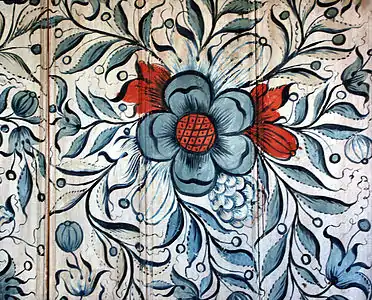 Rosemale painting
Rosemale painting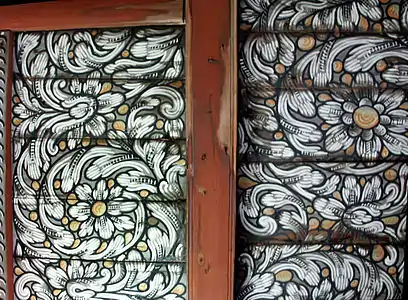 Rose painting
Rose painting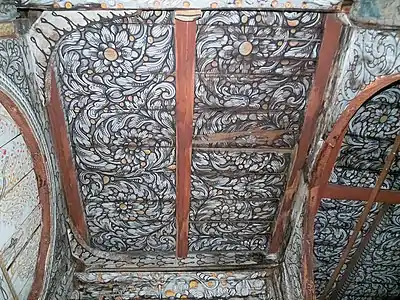 Painted Ceiling of the Nave in Uvdal Stave Church
Painted Ceiling of the Nave in Uvdal Stave Church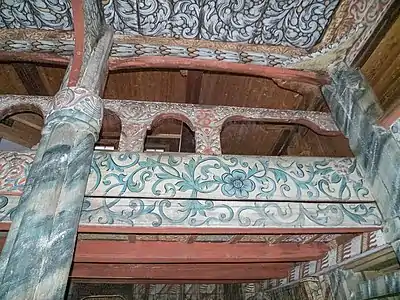 Upper Gallery of Uvdal Stave Church
Upper Gallery of Uvdal Stave Church
References
- Official dating by Riksantikvaren Archived 2005-04-28 at the Wayback Machine Directorate of Cultural Heritage in Norway
- Uvdal stavkirke Riksantikvaren under the guidance of H. Christie and J. H. Jensenius
- "Uvdal stavkirke". Den norske kirke. Retrieved September 15, 2016.
- "Uvdal stavkirke". Fortidsminneforeningen. Retrieved September 15, 2016.
Further reading
- Leif Anker (2005) The Norwegian Stave Churches (Oslo: Arfo Forlag) ISBN 978-8291399294
